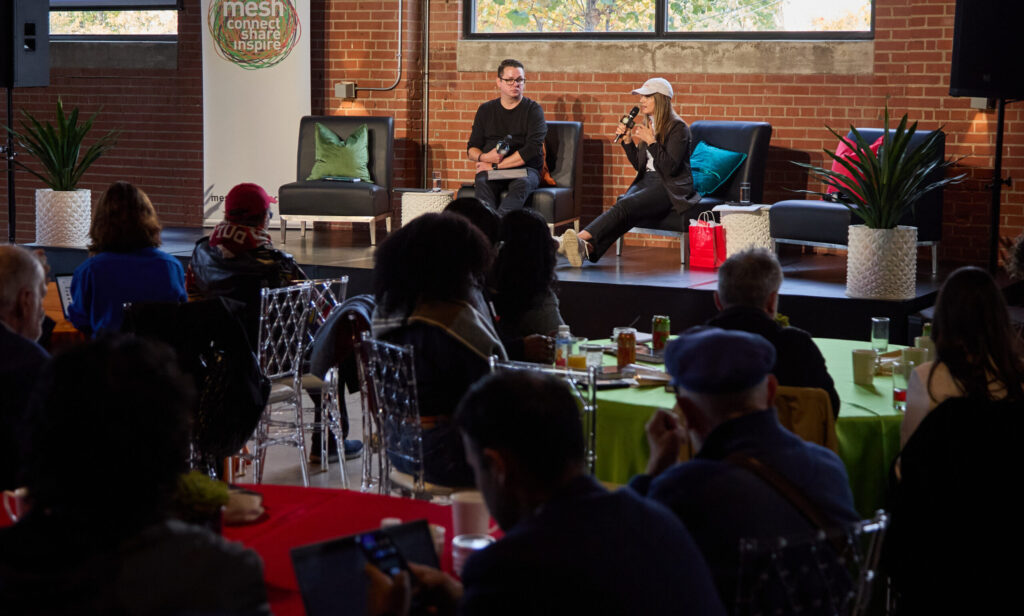Rethinking work and space at the mesh conference

The mesh conference: — Photo by © Ryan Francoz for Digital Journal
As the mesh conference made its way back to Toronto this week, attendees — lovingly dubbed “meshies” — gathered to explore the exciting intersection of design, technology, and the future of work.
With the theme “Building Our Future,” this year’s event dove deep into how architecture, engineering, construction and commercial real estate leaders can reflect and enhance our evolving work dynamics.
“The morning’s journey talked about the human side of transformation, the strategies that leaders deploy to manage change for people, and entrepreneurial journeys,” said Chris Hogg, co-producer of the mesh conference. “The afternoon looked at creating new opportunities, staring challenges in the face, and the ethical frameworks that guide teams.”
There was also the ever-present question of AI and how it fits into every facet of our lives now (even if we don’t exactly know it).

Rethinking work in the hybrid era
Digital transformation expert Kamales Lardi kicked off the day by highlighting a point people often miss when they talk about digital transformation: it’s not just about technology.
Real transformation should be a holistic, organization-wide ride that touches all business aspects, she said.
Lardi, who navigated the remote work landscape from her home base in Switzerland as CEO of Lardi & Partner Consulting, shared her experience of building trust in a virtual world. She said the key to achieving that is creating the right environment, because it’s about connection, not physical proximity.

“Working remotely doesn’t mean you don’t need that physical contact or touch point,” she said. “I truly believe that whatever hyper-personalized working model companies come up with, it has to be a hybrid model that allows for autonomy, where people get to design the work-life balance that suits their well being.”
Lardi highlighted that companies must adapt to this new model while still keeping the best parts of in-person interaction.
But it’s not a one-size-fits-all, said moderator David Potter.
“That’s the shiny thing we keep chasing, but it doesn’t exist because there’s no one answer for every company,” he said. “People are different, companies and communities are different — it’s about trying to figure out what the model is for your organization.”
Lardi shared research projecting $12 billion in spending on virtual office spaces by 2025. These tools have gone from niche to mainstream, and Lardi said it points to a future where collaboration won’t be tied to physical spaces.
As the conversation shifted to return-to-office policies, Lardi raised an important question: Are these decisions driven by business necessity or senior leaders’ comfort levels?
“I find that it’s about the comfort level of senior executives and leadership teams,” she said. “They want to go back into this physical space and they’re trying to bring their employees back.”
She stressed the importance of nurturing junior employees in remote settings, pushing back against the idea that learning should happen face-to-face.
One of the highlights of her talk was the introduction of her “motivation triangle,” featuring three critical elements for a thriving work culture:
- Autonomy: Employees need the freedom to design their work environments, whether that means working two days in the office and three from home, or choosing between different types of workspaces (quiet focus areas or collaborative spaces).
- Mastery: Workspaces should encourage continuous learning and development, offering places where employees can build new skills.
- Purpose: The physical workspace must reflect the company’s values. After all, if a company is serious about inclusivity, it should be evident in the design of its physical space.

Lardi also put a spotlight on trust as the foundation of any hybrid work model.
“If you don’t have that fundamental trust and belief in your employees, having them sit in your office doesn’t change anything,” she said.
It’s all about fostering a culture of collaboration and support. Lardi argued that an environment where employees are motivated and engaged.
“It’s do or die at this point,” she said.
Designing for the future of work
The future of the work is an ongoing conversation — has been for years — and it came up a lot at mesh.
Amanda Schneider, founder and president of ThinkLab, took the stage to unpack reasons why the future of work is an entanglement of HR, IT and design, and she shared a slew of studies and research points.

Echoing what Lardi had to say, it’s about creating spaces that “adapt to people” rather than forcing people to adapt to them.
It’s taking people longer to reach consensus, she said, especially in corporate environments, and it’s making things messy. The future of work demands serious silo-smashing in modern companies.
These departments need to stop acting like distant cousins at a family reunion and start collaborating.
She also said companies have to stop looking for quick fixes.
“I’m an American, and in America, we love magic pills,” she joked about the ways in which some leaders think. “Like, Ozempic, I don’t want to diet and exercise, I just want the magic pill.”
Schneider said there is no one-fix-for-everyone, and while some advocate for community-focused environments, others push for quiet, heads-down spaces.
“What’s exciting is it’s time to really question the way things have been done,” she added, noting that new prototypes and ways of working could emerge from this chaotic moment.

In discussing generational preferences, Schneider revealed a surprising twist in ThinkLab’s research: While many assume Gen Z are the most tech-forward, Schneider said her company’s research shows Gen Z is actually more aligned with Gen X and Baby Boomers in their work preferences. Their eagerness to return to physical office spaces underscores the importance of rethinking how these environments are designed.
With all the talk about rethinking how we live and work within spaces we design, the next discussion took a deeper look at the role of architects and how technology can reshape entire communities.
Ibrahim Greenidge, co-founder and managing director of Bolt Architecture, took the crowd of meshies on a trip back in time. He talked about reviving the idea of the “master builder” — those Renaissance architects who did it all, from design to construction.

Once upon a time, the architect didn’t just sketch the building and pass it off, they were the master builders. Greenidge described this as someone “skilled in the design and construction of buildings,” before being an architect was a bonafide profession.
Greenidge talked about purpose over paycheques, urging architects to blend design, sustainability, and technology in ways that make our world better.
Purpose became a priority for Greenidge early in his career when he started to notice a “regurgitation of ideas,” where prisons were starting to look like the schools, which then started to look like affordable housing complexes, he said. And he wanted to change that.
With the help of digital innovations and a holistic mindset, Greenidge argues that architects are finally reclaiming their status as modern master builders.
Today architects are using BIM, 3D modeling, drones, and AI to create designs that go far beyond just being functional or aesthetic — they’re about social impact, Greenidge said. And he’s not just talking the talk. He incorporates what he calls the “Inhabitant Bill of Rights,” which includes the right to clean water, clean air, and access to fresh food, co-generative housing, and green spaces.
Greenidge doesn’t think tech is the enemy — in fact, he said it’s a crucial tool — but was quick to remind the mesh audience that engaging with AI requires conversation, so architects entering the profession need to learn communication skills along with technical prowess.
“The only way you use AI is if you know what to tell it,” he said.

Greenidge’s passion also lies in mentoring the next generation. His interest in architecture bubbled up at just nine years old, and he’s now focused on inspiring young people, particularly those from underrepresented communities, to follow a similar path.
“We need voices from all over different parts of the world,” he says.
In the end, Greenidge said architects need to put their egos aside and create space that serves everyone, not just spaces that are beautifully designed.
Rethinking construction with technology
In the afternoon, the conversation moved to architecture, engineering, and construction (AEC), and how entrepreneurs and investors are seeking to disrupt old ways of doing things.
A trio of disruptors held a panel exploring seismic shifts happening as property technology (aka PropTech), AI, and modular construction challenge traditional industry norms. Moderated by Elena Yunusov, executive director of the Human Feedback Foundation, the panel featured Stephanie Wood from Alate and Dr. Hamid Alemohammad, co-founder of Brickeye.
Wood kicked things off with an eye-opening stat on the rise of PropTech, saying, “Back in the early 2000s, there was only about $1 or $2 billion a year invested across the world in the PropTech industry.” But by 2021, that number skyrocketed to $30 billion.

Alemohammad emphasized that while AI is transforming the industry, it’s not a cure-all.
“We see AI as a tool,” he explained, stressing that it complements human expertise rather than replaces it. Brickeye uses AI alongside sensor networks to provide real-time data on construction sites, leading to smarter decisions and safer, more sustainable projects.
Alemohammad also underscored the challenges that digitization brings.
“Cyber threats are becoming more mature,” he said. “So part of our work is to stay ahead of that,” he warned, reminding the audience that technology can bring with it new responsibilities.
Why AI isn’t as intelligent as you might think
Wrapping up the day, a panel discussion on ethical AI frameworks left the mesh audience thinking about the responsibility organizations and leaders carry when they deploy AI solutions into their workplace.
One of the central themes was the danger of anthropomorphizing AI. While AI systems may appear to mimic human responses, the panelists were quick to clarify that this is an illusion.
“AI is not intelligent,” said Ivey Chiu, program manager of special projects and innovation at Telus. “It’s not actually responding to you, it’s just statistics at the end of the day.”

Charitarth Bharti with the privacy and data trust practice at EY echoed this sentiment, noting that AI systems don’t think or reason like real people. He cautioned the audience against treating AI as if it were capable of independent thought.
As for regulation, skepticism ran high about Big Tech’s ability to ethically govern AI.
“A lot of communities are coming together to make sure that AI isn’t regulated by Meta, by OpenAI,” noted Anne-Marie Enns, stressing the importance of keeping power away from those who stand to profit most.
Rose Genele, CEO of transformation consultancy The Opening Door, noted that while companies may claim transparency, the complexities inherent in AI systems can obscure how decisions are made.
“Big Tech talks about fairness, accountability and transparency, but when profit is the main driver these principles often take a backseat,” she said. “It’s hard to trust companies to regulate themselves when their incentives are misaligned.”
The panel emphasized that AI ethics should be embedded in company culture, not treated as a checklist.
Telus’ Chiu highlighted the need for AI practitioners to internalize ethical responsibilities, while Genele pointed out that while regulation is crucial, real change happens when organizations take these issues to heart.
The discussions at mesh Toronto made it clear that the future of work, design, and technology is an evolving puzzle, requiring continuous adaptation and collaboration.
Whether it’s redefining hybrid models, breaking down silos, or embracing digital tools responsibly, leaders must rethink old frameworks and build solutions that truly serve people.
As the conference moves to Calgary on April 29-30 next year, the conversation will no doubt continue to challenge assumptions and inspire new approaches to building our future.
Rethinking work and space at the mesh conference
#Rethinking #work #space #mesh #conference




